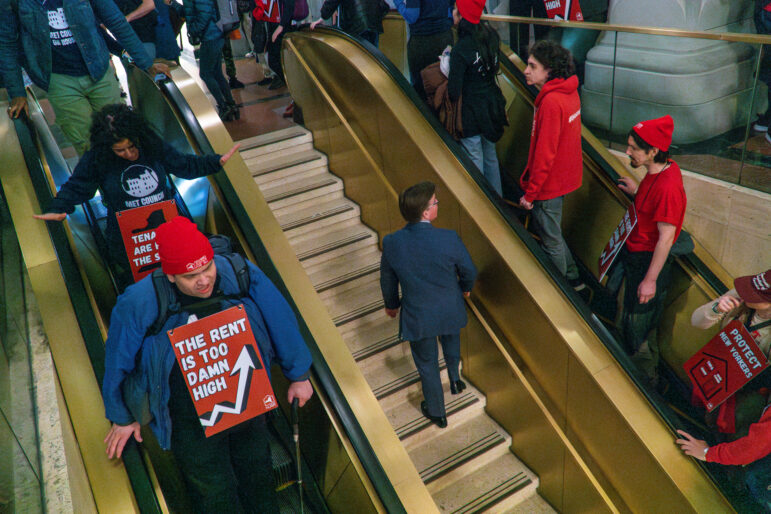“While increasing the housing supply is critical and has saturated most of the housing conversation, new housing will take years to come online. In the meantime, affordability is still a concern to many New Yorkers.”

Chris Janaro
Tenant organizers rallying at the Capitol building in Albany on March 19, 2024.Another state budget has come and gone, and renters are still facing the same problem: how to pay their rent. While increasing the housing supply is critical and has saturated most of the housing conversation, new housing will take years to come online. In the meantime, affordability is still a concern to many New Yorkers.
Before lawmakers close the book on this legislative session, they should work with property owners, tenant groups, social service organizations, religious organizations, and tens of thousands of renters to pass the Housing Access Voucher Program (HAVP), a state-funded voucher designed to work like the federal Housing Choice Voucher Program (Section 8).
HAVP would be accessible to households that make less than 50 percent of the Area Median Income, which is $54,350 for an individual or $77,650 for a family of four. While it is focused primarily on helping homeless families, it would also be available to many low-income tenants who are struggling to pay rent.
Many of the those who would be eligible for HAVP live in rent-stabilized buildings. Our members see tenants’ struggles firsthand, even with rents that average $1,300. They report that about one quarter of all renters in low-income neighborhoods fall behind in their rent at least once a year.
The current system creates a merry-go-round of eviction filings, drawn out and costly court proceedings, one-shot government assistance, until eventually, arrears accumulate again. We must break this cycle.
This is why HAVP is the answer lawmakers are looking for when it comes to helping tenants. Renters would not need to face eviction proceedings in order to receive help. Once a housing provider gives them a “rent demand”—which is a legally required document that housing providers must present to tenants who fall into arrears—the tenant can apply for HAVP.
We estimate more than 100,000 rent-stabilized households on fixed incomes would be eligible for HAVP. Since rent-stabilization is not means tested, the apartments with the lowest rents often don’t go to low-income renters. This means low-income families in higher-rent apartments are often subsidizing apartments in the building with lower rents, and paying more than 30 percent of their income towards housing.
HAVP would keep these tenants from becoming another statistic. With an HAVP voucher, a tenant would pay a manageable 30 percent of their household income towards rent. That means a tenant making minimum wage with a rent of $1,300 a month, the average price for a rent-stabilized apartment, would only have to pay $832 a month. The state would cover the additional $468, keep the tenant from drowning, while also ensuring the building has operating funds. This would save that renter $5,616 a year, which could be the difference between staying in their home or ending up on the street.
One of the reasons HAVP hasn’t passed yet, despite widespread support across the spectrum of housing and tenant advocates, is allegedly the cost. But considering the massive amount of money the state and city are already paying for social services to deal with the impacts of homelessness and the rising costs of vouchers that HAVP could eventually replace, it is actually a sound investment.
Not only would HAVP prevent evictions, but it would make good economic sense. Nearly every cent spent on a housing voucher makes its way back into the government’s coffers via property tax, regulatory fees, utilities, and local economic activity. It’s the best investment a government can make in its people.
Though HAVP requires budgeting, we don’t need to wait for next year’s budget negotiations to begin this process. If lawmakers pass the bill establishing HAVP this session, it would kickstart the process of implementing the program. The governor could set up rules for the program’s implementation, and agencies can prepare for enactment. If we wait until next year’s budget, it won’t be available to any tenants until closer to 2026 and implemented until 2027. Renters can’t wait that long.
Once implemented, New York City will have federal, state and city voucher programs to help renters. Federally-funded Section 8 vouchers total approximately $1.9 billion, and the CityFHEPS vouchers cost New York City about $650 million. An additional $500 million from the state would create an additional layer of the social safety net to ensure more renters get the relief they need. Eventually, these programs could all be rolled into HAVP with New York City using its existing CityFHEPS funding for a universal HAVP voucher.
There is still so much to be done to fix housing policy in New York. Let’s start by passing the Housing Access Voucher Program before the end of the session and provide some affordability to renters, now.
Jay Martin is the executive director of the Community Housing Improvement Program (CHIP)








